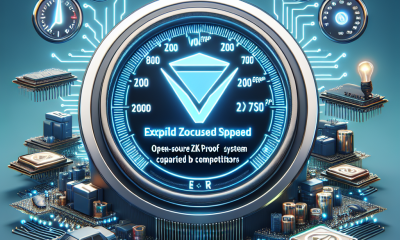Altcoins
Altcoin Market Poised for Explosive Rally, Analysts Eye Three Key Indicators for Movement Confirmation

In the dynamic world of cryptocurrency, trends and market sentiments shift rapidly, often leaving investors in a state of flux. Currently, the altcoin sector appears to be on the cusp of a significant transformation. According to observations by seasoned crypto analysts, we are at what is described as the “disbelief stage” within the market cycle. This particular phase is characterized by investor skepticism, despite promising market trends that hint at a potential upturn. Traditionally, this stage lays the groundwork for what can evolve into an explosive rally.
Crypto trader Milkybull, with a substantial following of 66,700 on social media, has recently shed light on the current market conditions. A post from May 11 highlights that the total market capitalization of altcoins, excluding the top 10 cryptocurrencies, has experienced a downturn of 17.65% over the last month, settling at approximately $265 billion according to TradingView data. Despite this decline, the market is seemingly primed for an upswing, still maintaining above the critical $250 billion support level.
Adding to the discourse, another prominent figure in the crypto trading community, known by their pseudonym Rekt Capital, echoed similar sentiments to their 465,000 followers. On May 12, Rekt Capital suggested that the market is positioning itself for a future upward trajectory, implying that the current status quo may very well serve as the calm before the storm.
The anticipation of an impending rally is not unfounded but is rather grounded in the analysis of specific technical indicators that serve as the linchpin for such predictions. Among these, the Exponential Moving Average (EMA) over 20 days, the Stochastic RSI, and bitcoin dominance are crucial metrics that traders are closely monitoring.
The EMA provides an average price over a chosen period, placing more weight on recent price actions, which helps in identifying market trends. On the other hand, the Stochastic RSI, a derivative of the standard RSI, measures the relative strength or weakness over a specific period, offering insights into potential reversal points. Titan of Crypto, another analyst with a keen eye on the market, pointed out in a May 11 update that a bullish cross on the Stochastic RSI, coupled with a retest of the EMA20, could very well signal the beginning of a “rally time.”
Another critical aspect influencing market predictions is Bitcoin’s dominance ratio, which serves as an indicator of its market share in comparison to the broader crypto market. Currently, Bitcoin’s dominance stands at a slightly adjusted figure of 54.8%, showing a small decline from previous readings. This metric is a useful gauge for investor sentiment and risk appetite, with a decrease often indicating increased interest in altcoins.
Furthermore, it’s essential to contextualize these developments within the broader narrative of the cryptocurrency market. Historical data and patterns suggest that periods of downturn or consolidation, such as the one currently observed, frequently precede significant uptrends. The analysis of these patterns, combined with current market indicators, paints a scenario where an altcoin rally might indeed be on the horizon.
However, as with any form of investment, especially in the highly volatile crypto market, there is an inherent risk. Investors are urged to conduct thorough research and possibly consult financial advisors before making any significant investment decisions. The current market conditions, while promising, are not a guaranteed predictor of future performance.
Overall, the mood among crypto analysts is one of cautious optimism, with the prevailing sentiment leaning towards the potential for significant market movements in the near term. Whether this will materialize as forecasted remains to be seen, but for now, the amalgamation of technical indicators and historical trends suggests that the stage may be set for the next major rally in the altcoin market.
Altcoins
South Korea to Reassess 600 Cryptocurrencies for Exchange Compliance Under New User Protection Act

In a significant move to enhance investor protection and ensure compliance with emerging regulations, South Korea’s financial authorities are set to initiate a reviewing process for around 600 cryptocurrencies currently traded on domestic platforms. This decisive step comes in the light of the newly enacted Virtual Asset User Protection Act, which will come into force on July 19th. The Act is part of South Korea’s broader strategy to establish a more regulated and secure digital asset environment.
The impending review underscores a paradigm shift in how South Korea governs its bustling crypto market. Traditionally, crypto exchanges in South Korea independently conducted internal assessments to decide which digital assets to list. However, under the newly introduced best practice plan, a more rigorous process instituted by government authorities will supplement these reviews. As a result, every cryptocurrency seeking listing on local exchanges must now satisfy a set of stringent requirements outlined by the financial watchdogs.
Amid growing concerns over potential delistings triggered by heightened regulatory scrutiny, an official from the financial regulatory body underscored the inevitability of withdrawing support for digital assets that fail to meet the new maintenance standards. This statement signals a firm governmental stance on ensuring the utmost quality and security of cryptocurrencies available to South Korean investors.
Key among the nine stringent listing requirements are the assurances of a cryptocurrency’s structural suitability for listing, the reliability of its issuer, the implementation of protections for users, an evaluation of its technological security robustness, and its adherence to local regulations and laws. Notably, the reliability assessment of issuors will involve scrutinizing their disclosure practices and verifying the circulation of the cryptocurrency.
Of paramount concern to authorities is also the cybersecurity of digital assets. To this end, cryptocurrencies that have experienced hacking incidents or those that fail to disclose their smart contract source codes will be deemed ineligible for listing. Additionally, coins and tokens directly issued by exchanges, alongside those obscuring transaction histories or contravening current legal standards, will be precluded from listing.
Nevertheless, the review process extends beyond merely ticking off a checklist of formal requirements. Cryptocurrencies seeking listings must convincingly demonstrate thorough disclosure practices, a logical issuance and circulation model, and a reliable business track record. Moreover, even if a digital asset satisfies all formal criteria, it may still face scrutiny and potentially not be listed based on qualitative evaluations—except for those assets which have been traded on well-regulated foreign exchanges for more than two years without issues.
South Korea, housing 29 domestic crypto exchanges with Upbit leading by virtue of having the 13th highest trading volume globally as per CoinGecko data, is bracing for the potential ramifications of this regulatory overhaul. The new measures are poised to significantly impact the local crypto market, especially given that altcoins represent over 60.5% of the market’s trading volume. Cryptocurrencies that exhibit low trading volumes or have issues with their listing disclosures are anticipated to face delisting first.
This comprehensive approach by South Korean authorities illustrates a concerted effort to not only safeguard investors but also instill greater transparency and accountability in the domestic cryptocurrency landscape. As the global interest in digital assets continues to burgean, such regulatory initiatives could serve as a blueprint for other nations grappling with the challenges of overseeing a rapidly evolving and often volatile digital asset market.
Altcoins
Spot Ethereum ETF Approval Signals Bright Future for Ethereum, Asserts Kaiko Research

Kaiko Research’s recent announcement regarding the approval of spot ethereum ETFs by regulatory bodies has sparked optimism in the cryptocurrency sector. This development is seen as a significant milestone for Ethereum, potentially paving the way for its long-term growth. The regulatory green light not only clarifies Ethereum’s classification but also indicates a broader acceptance of digital assets in the financial markets.
Ethereum, often hailed as the leading altcoin, has been at the forefront of discussions concerning regulatory compliance and market viability. Will Cai, Head of Indices at Kaiko, remarked on the decisive nature of the U.S. Securities and Exchange Commission’s (SEC) stance towards Ethereum. According to Cai, the SEC’s approval solidifies Ethereum’s status as a commodity, setting a critical precedent for the regulatory treatment of other digital tokens within the U.S. market. This distinction is vital for Ethereum’s adoption and integration into the global financial system.
However, the journey towards full regulatory approval still requires the clearing of additional hurdles, including the SEC’s review of the ETFs’ S-1 orders. The anticipation surrounding these developments suggests that spot Ethereum ETFs could become available in the near future, introducing a new chapter in cryptocurrency investment strategies.
Despite the optimistic outlook, the immediate impact may bring some volatility, especially for existing investment products like Grayscale’s Ethereum fund (ETHE). With over $12 billion in assets under management, the transition of ETHE into an ETF format is expected to lead to approximately $112 million in average daily outflows. This potential shift recalls the experience of the Grayscale bitcoin fund (GBTC), which saw significant withdrawals during its first month of ETF conversion. Nevertheless, the subsequent balance achieved through other ETFs hints at a stabilizing effect likely to benefit Ethereum in the long term.
On the international stage, Ethereum ETFs have faced challenges, particularly in Hong Kong, where they have experienced $4.5 million in net outflows since their launch. This contrast with the U.S. developments underlines the varied reception of cryptocurrency investment products across different markets.
Kaiko’s analysis extends to the broader impacts on Ethereum’s market dynamics, noting significant changes in trading patterns and market depth following the FTX collapse. The decreased market concentration in the U.S., from 50% to 41%, reflects a decentralization trend and underscores the shifting landscape of Ethereum trading. These developments signal a complex interplay of regulatory, market, and technological factors influencing Ethereum’s future.
The approval of Ethereum ETFs marks a significant milestone in the integration of cryptocurrencies with traditional financial markets. As regulatory clarity improves and investment mechanisms evolve, Ethereum stands at a critical juncture, poised for long-term growth amid short-term challenges. The unfolding landscape presents opportunities for innovation, investment, and broader acceptance of digital assets, framing the next chapter in the cryptocurrency narrative.
Altcoins
Ethereum Bullish Trend Gains Traction as Accumulation Addresses Skyrocket, Signaling Market Optimism

ethereum, the blockchain platform known for its versatility and smart contract functionality, is witnessing a bullish trend as indicated by the surge in accumulation addresses. Accumulation addresses refer to wallets that have experienced withdrawals or transfers, encompassing both cold (offline) and hot (online) storage solutions. This uptick in accumulation is a critical indicator of market sentiment, often analyzed by market experts to forecast future price movements.
Recent data from on-chain analysis firm CryptoQuant has revealed a noteworthy increase in the number of Ethereum accumulation addresses. The number has risen to over 3,720 wallets, signaling a robust interest from holders. This is particularly evident when dissecting the data further into two distinct classifications of wallets: those holding between 10 to 10,000 eth and those with 10,000 to 100,000 ETH. The former group now holds approximately 247,150 ETH, while the latter controls around 374,200 ETH as of May 26. Comparatively, on May 1, these figures were significantly lower, 22.7K ETH for the former group and 30.2K ETH for the latter, highlighting a remarkable increase in holdings.
Parallel to this, Ethereum whales – entities with substantial quantities of ETH – have also been noted for their bullish activities. The transaction value exceeding $100,000 has hit a new peak this year, as reported by IntoTheBlock, suggesting an aggressive accumulation by larger holders. This surge in whale transactions is partly inspired by growing interest from traditional finance investors looking for lucrative opportunities in the digital asset space.
The ripple effect of this bullish sentiment is also visible in Ethereum’s trading volume, which has seen a significant upsurge. This is indicative of the growing confidence among investors about Ethereum’s market potential, further buoyed by the anticipation of a sustained price rally. Such a trend not only benefits Ethereum but also sets a positive tone for the wider altcoin market.
An interesting factor contributing to the heightened accumulation activity is the approval of spot bitcoin ETFs earlier this year, which propelled the Bitcoin price to an all-time high of over $73,150. Following Bitcoin’s lead, investors have also turned their attention to Ethereum, in anticipation of a similar momentum post the approval of spot Ethereum ETFs. The speculation surrounding these approvals has been a catalyst for the recent price surge, with Ethereum’s price hovering around $3,952, marking a 2.5% increase over the last 24 hours and a 25.5% weekly rally.
In an intriguing development, a significant Ethereum whale transaction was recorded, involving the transfer of 42,392 ETH to an unknown wallet. Such movements are closely watched by market analysts as they can provide insights into potential market directions.
Furthermore, the crypto community remains buoyant about other digital assets as well, with the FLOKI price witnessing a 23.5% increase, buoyed by soaring social sentiment. These patterns indicate a market that is increasingly driven by both speculative interest and genuine belief in the long-term value proposition of digital currencies.
In testament to the excitement surrounding Ethereum, and the broader crypto market, the latest trends in accumulation addresses and whale transactions underscore a positive market sentiment. As the digital asset landscape continues to evolve, Ethereum’s position as a cornerstone technology, combined with rising investor interest, suggests a promising future for its valuation and broader adoption within the digital economy.
-

 Cryptocurrency3 months ago
Cryptocurrency3 months agoExploring the Future of Finance: Regulated Settlement Network PoC Aims to Unify Banking and Securities on a Single Platform
-

 Cryptocurrency2 months ago
Cryptocurrency2 months agoFantom Foundation Boosts Blockchain Performance with Opera Upgrade to Hit 2000 TPS, Following Google Cloud Partnership
-

 Cryptocurrency3 months ago
Cryptocurrency3 months agoProtocol Village Announces ‘Expander’: An Open-Source ZK Proof System Doubling Speed Compared to Competitors
-

 Cryptocurrency3 months ago
Cryptocurrency3 months agoOpenAI Gears Up for Exciting ChatGPT Update: New Features and Potential Pricing Changes on the Horizon
-

 Altcoins2 months ago
Altcoins2 months agoFive Altcoins Including Pepe Coin and FLOKI Eye Major Gains: A Path to Turn $10,000 into $1 Million Revealed
-

 Cryptocurrency3 months ago
Cryptocurrency3 months agoMember of REvil Ransomware Syndicate, Rabotnik, Receives 13-Year Jail Sentence
-

 Cryptocurrency3 months ago
Cryptocurrency3 months agoDropbox Suffers Significant Data Breach: A Detailed Look at the Incident
-

 Altcoins2 months ago
Altcoins2 months agoFetch.ai (FET) Faces Potential Correction as Investor Support Wanes and Death Cross Looms



